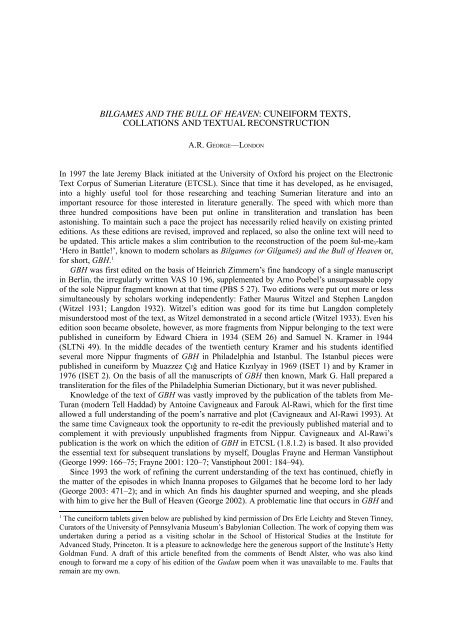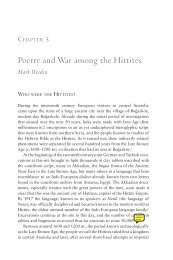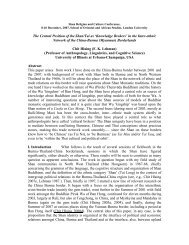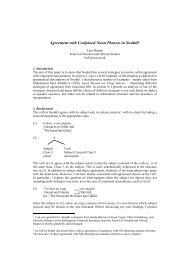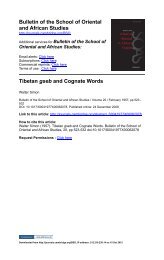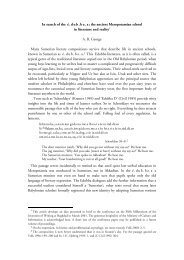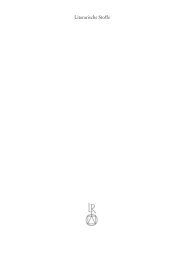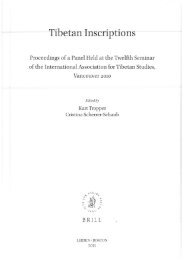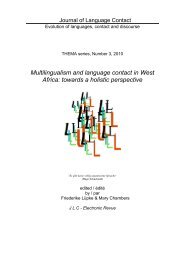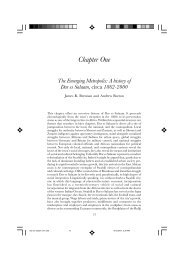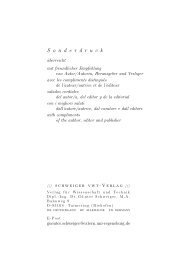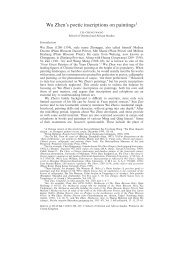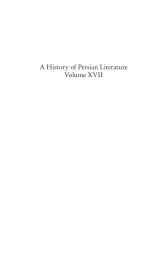cuneiform texts - SOAS Research Online
cuneiform texts - SOAS Research Online
cuneiform texts - SOAS Research Online
Create successful ePaper yourself
Turn your PDF publications into a flip-book with our unique Google optimized e-Paper software.
BILGAMES AND THE BULL OF HEAVEN: CUNEIFORM TEXTS,<br />
COLLATIONS AND TEXTUAL RECONSTRUCTION<br />
A.R. GEORGE—LONDON<br />
In 1997 the late Jeremy Black initiated at the University of Oxford his project on the Electronic<br />
Text Corpus of Sumerian Literature (ETCSL). Since that time it has developed, as he envisaged,<br />
into a highly useful tool for those researching and teaching Sumerian literature and into an<br />
important resource for those interested in literature generally. The speed with which more than<br />
three hundred compositions have been put online in transliteration and translation has been<br />
astonishing. To maintain such a pace the project has necessarily relied heavily on existing printed<br />
editions. As these editions are revised, improved and replaced, so also the online text will need to<br />
be updated. This article makes a slim contribution to the reconstruction of the poem šul-me3-kam<br />
‘Hero in Battle!’, known to modern scholars as Bilgames (or Gilgameš) and the Bull of Heaven or,<br />
for short, GBH. 1<br />
GBH was first edited on the basis of Heinrich Zimmern’s fine handcopy of a single manuscript<br />
in Berlin, the irregularly written VAS 10 196, supplemented by Arno Poebel’s unsurpassable copy<br />
of the sole Nippur fragment known at that time (PBS 5 27). Two editions were put out more or less<br />
simultaneously by scholars working independently: Father Maurus Witzel and Stephen Langdon<br />
(Witzel 1931; Langdon 1932). Witzel’s edition was good for its time but Langdon completely<br />
misunderstood most of the text, as Witzel demonstrated in a second article (Witzel 1933). Even his<br />
edition soon became obsolete, however, as more fragments from Nippur belonging to the text were<br />
published in <strong>cuneiform</strong> by Edward Chiera in 1934 (SEM 26) and Samuel N. Kramer in 1944<br />
(SLTNi 49). In the middle decades of the twentieth century Kramer and his students identified<br />
several more Nippur fragments of GBH in Philadelphia and Istanbul. The Istanbul pieces were<br />
published in <strong>cuneiform</strong> by Muazzez Çığ and Hatice Kızılyay in 1969 (ISET 1) and by Kramer in<br />
1976 (ISET 2). On the basis of all the manuscripts of GBH then known, Mark G. Hall prepared a<br />
transliteration for the files of the Philadelphia Sumerian Dictionary, but it was never published.<br />
Knowledge of the text of GBH was vastly improved by the publication of the tablets from Me-<br />
Turan (modern Tell Haddad) by Antoine Cavigneaux and Farouk Al-Rawi, which for the first time<br />
allowed a full understanding of the poem’s narrative and plot (Cavigneaux and Al-Rawi 1993). At<br />
the same time Cavigneaux took the opportunity to re-edit the previously published material and to<br />
complement it with previously unpublished fragments from Nippur. Cavigneaux and Al-Rawi’s<br />
publication is the work on which the edition of GBH in ETCSL (1.8.1.2) is based. It also provided<br />
the essential text for subsequent translations by myself, Douglas Frayne and Herman Vanstiphout<br />
(George 1999: 166–75; Frayne 2001: 120–7; Vanstiphout 2001: 184–94).<br />
Since 1993 the work of refining the current understanding of the text has continued, chiefly in<br />
the matter of the episodes in which Inanna proposes to Gilgameš that he become lord to her lady<br />
(George 2003: 471–2); and in which An finds his daughter spurned and weeping, and she pleads<br />
with him to give her the Bull of Heaven (George 2002). A problematic line that occurs in GBH and<br />
1 The <strong>cuneiform</strong> tablets given below are published by kind permission of Drs Erle Leichty and Steven Tinney,<br />
Curators of the University of Pennsylvania Museum’s Babylonian Collection. The work of copying them was<br />
undertaken during a period as a visiting scholar in the School of Historical Studies at the Institute for<br />
Advanced Study, Princeton. It is a pleasure to acknowledge here the generous support of the Institute’s Hetty<br />
Goldman Fund. A draft of this article benefited from the comments of Bendt Alster, who was also kind<br />
enough to forward me a copy of his edition of the Gudam poem when it was unavailable to me. Faults that<br />
remain are my own.
102 A.R. GEORGE, BILGAMES AND THE BULL OF HEAVEN<br />
in other Sumerian poems of Gilgameš has attracted two very different elucidations (George 2003:<br />
10 n. 29; Marchesi 2001). 2<br />
The purpose of the present contribution is threefold: first, to make available <strong>cuneiform</strong> copies of<br />
Nippur manuscripts now in the University Museum in Philadelphia, most of which have hitherto<br />
been published in transliteration only; second, to note where I read traces on these pieces<br />
differently from Cavigneaux; and third, to offer alternative reconstructions of two passages by<br />
combining manuscripts that he transliterated separately or in other combinations. These are matters<br />
of detail and in no way detract from Cavigneaux’s magnificent achievement in providing the field<br />
for the first time with a definitive edition of the text of GBH in a substantially complete form.<br />
CUNEIFORM COPIES<br />
There are currently eighteen fragments of GBH from Nippur: one of Ur III date, booked as ms. Na<br />
in Cavigneaux’s list of sigla (Cavigneaux and Al-Rawi 1993: 101), and seventeen Old Babylonian<br />
pieces (Cavigneaux’s Nb–Nr). The other extant witnesses are ms. A (VAS 10 196) and the two<br />
tablets from Me-Turan (Ma and Mb), which all present the text in non-standard orthography. Of the<br />
Nippur manuscripts seven had already been published in <strong>cuneiform</strong> by 1993 (Na, Nb, Nd, Ng, Nj,<br />
Nk, Nm), along with one fragment that was subsequently joined to three uncopied pieces (Ni). In<br />
addition, <strong>cuneiform</strong> copies of mss. Nn and Np had been already made by the late Aaron Shaffer,<br />
partly from casts, but they remained unpublished, as did a copy of ms. Nl by Claus Wilcke. Copies<br />
of mss. Ni, Np and another fragment (No) were published by me as witnesses to the episode of<br />
Inanna’s weeping (George 2002: 146–7). In the winter of 2004–5 I continued the work of copying<br />
the <strong>cuneiform</strong> of GBH, and made copies of all the remaining manuscripts in Philadelphia (Nc, Nf,<br />
Nh, Nl, Nn), as well as a new copy of the piece previously published in <strong>cuneiform</strong> by Chiera as<br />
SEM 26 (Nj). These appear here as Figs. 1–7.<br />
This does not complete the publication of GBH in <strong>cuneiform</strong>. Three Nippur fragments from the<br />
thirteenth campaign were identified by Miguel Civil and communicated to Cavigneaux in<br />
transliteration (Ne, Nq, Nr from the 13 N-T collection). I have not seen these, either in cast (in<br />
Chicago) or in the original (Baghdad). 3<br />
2 i3-a LUM.LUM u3-luḫ-ḫa su3-su3, which I translated ‘Ho, hurrah! Tall-grown sapling’. Gianni Marchesi’s<br />
exposition, that this difficult line means ‘O oil-glistening one, adorned with the staff of command’, is<br />
attractive, though Miguel Civil (2003b: 83) has meanwhile reasserted his view that u3-luḫ-ḫa means not<br />
‘sceptre’ but ‘offshoot’. A further difficulty is the inordinate number of variant writings of i3-a LUM.LUM:<br />
i3-a-lu2-ulu3, i3-a-lul-lu-un, ia-lu2-ulu3, ia4-LUM-LUM, ia4-a-LUM-LUM, ia4-LUM, a-LUM-LUM, all<br />
documented in George 2003: 10 n. 29. This variation demonstrates that ancient scribes often failed to<br />
understand the epithet and sought other etymologies; as one of these possibilities I would still propose an<br />
ululation *yalulu related to Akk. yarūru (for the phonetic rendering of ululations in Sumerian see Krecher<br />
1966: 148–9; Civil 1976: 90; Attinger 1993: 559). The proposed epithet ‘oil-glistening’ at the opening of the<br />
paean to Gilgamesh is a prominent attribute of the hero as king of Uruk. This begs the question of whether<br />
anointment with oil played a part in coronation in Mesopotamia. Biblical and other sources suggest the<br />
anointing of kings was predominantly a Levantine and Anatolian practice, perhaps borrowed from Egypt,<br />
where vassals and other subordinates were bound to pharaoh’s service by anointment (e.g., de Vaux 1973:<br />
102–7). Amorite kings of Mari were anointed on accession, as is clear from Adad of Aleppo’s oracle to<br />
Zimri-Lim: šamnam(I3) ša nam-ri-ru-ti-ia ap-šu-uš-ka ‘I anointed you with the oil of my splendid brilliance’<br />
(Durand 1993: 45, 4´–5´). Here again the anointment binds the anointed in the service of the anointer.<br />
Evidence for the anointment of kings is lacking for southern Mesopotamia, however (Durand 1993: 53), a<br />
lack that undermines Marchesi’s proposal.<br />
3 A further manuscript, now in the Schøyen Collection, is expected to appear in a volume of Sumerian literary<br />
tablets (see for the moment George 2003: 967 sub SC 2652/2). Another tablet in the Schøyen Collection, MS<br />
(= SC) 2652/3, was formerly identified as an Old Sumerian source for GBH but without justification (see<br />
George 2003: 6). Unfortunately, early misinformation put out on the collection’s website has contaminated<br />
Bendt Alster’s (2004: 33–4 n. 15, 35 n. 20) discussion of the literary history of GBH.
Figure 1: Ms. Nc<br />
Figure 3: Ms. Nh<br />
YOUR PRAISE IS SWEET: MEMORIAL VOLUME FOR JEREMY BLACK 103<br />
Figure 2: Ms. Nf obverse and reverse
104 A.R. GEORGE, BILGAMES AND THE BULL OF HEAVEN<br />
Figure 4: Ms. Nj<br />
Figure 5: ms. Nl obverse and reverse
YOUR PRAISE IS SWEET: MEMORIAL VOLUME FOR JEREMY BLACK 105<br />
COLLATIONS<br />
Collations of mss. A, Ni, No and Np of GBH have previously been offered in George 2002 and<br />
2003: 11 n. 47. Further collations of ms. A and notes on the six newly copied pieces follow.<br />
A. VAT 6281<br />
VAS 10 196 (ed. Cavigneaux and Al-Rawi 1993: 112–21). Col. i 12´ and 13´: tur3-zu and amaš-zu,<br />
as in the parallel lines of the Gudam poem (Römer 1991: 367, A rev. 31–2; Alster 2004: 25, 36–7<br />
[= ETCSL 1.3.4]); end of i 14´: ga-an-dug4-e : ga-; i 16´: g]u3 ⸢ba-an-de3⸣; i 17´–18´:<br />
[… d GIŠ.G]A.BIL2-mes za-e ma-i-ra-an-dug4, [… d GIŠ.G]A.BIL2-mes za-ra-ra ma-an-dug4; ii 5´: ušbi<br />
du[g-šakar-gin7 … ] (// No rev. 6´); ii 18´ end: an-nu-rug-gu3-bi 4 for an-ur2-ra u2-gu7-bi-(im) (//<br />
Nm obv. 2 // Np ii 10´); iii 30´: ša3-ba!(ZU) nu-te-te-en; iii 31´ end: im-si-mu-e; iii 38´: i3-na8-na8-e<br />
[ … ; iv 15: mu-un--eš<br />
Nc. 3 N-T 917, 387<br />
Figure 1 (ed. Cavigneaux and Al-Rawi 1993: 104). In l. 5´, where Ninsun appears to be instructing<br />
Gilgameš to bathe in the river, id2-da e11-ni saḫar šu x […] is parallel with the Me-Turan<br />
manuscript’s saḫar-ta a-ni-[x] id2-da naga-NE (Ma 7). The trace allows šu x […] to be read<br />
ŠU.N[AGA, i.e., t[u5-bi2-ib2] ‘wash’.<br />
Nf. 3 N-T 902, 94<br />
Figure 2 (ed. Cavigneaux and Al-Rawi 1993: 113–14). Perhaps part of the same tablet as Nh. The<br />
first line has traces which read not -r]i-bar-re (like ll. 2´ and 3´) but -me-e]n-⸢de3-en⸣. Lines 1´–2´<br />
thus combine into one line of poetry: [en d bil3-ga-mes am-mu lu2/mu-lu-me-e]n-de3-en 2´ [šu nu-r]ibar-re<br />
(l. 2´ indented). Lines 6´–7´ read in Emesal [ d bil3-ga-mes za-e u3-mu-u]n-bi de3-men3<br />
7´ [ga2-e ga-ša-an-bi] de3-men3 (see below). Line 8´: the sign NI is clear. Rev. 6: b]a-an-{PA ras.}-pa-<br />
{ras.}.<br />
Nh. 3 N-T 906, 227<br />
Figure 3 (ed. Cavigneaux and Al-Rawi 1993: 111–13). Perhaps part of the same tablet as Nf. Line<br />
3´ end: the scribe accidentally omitted the sign LA2 before ⸢e⸣.<br />
Nj. CBS 11350<br />
Figure 4. SEM 26 (ed. Cavigneaux and Al-Rawi 1993: 117–18). This is a surface flake from the<br />
reverse of a tablet probably of four columns. The right-hand column is thus col. iii; the line-ends on<br />
the left-hand column are still unplaced (iv 1´–6´). Rev. iii 1´–2´ reads [i3-na8-na8-e]n ⸢i3-na8⸣-[na8-en<br />
en-še3 i3-na8-na8-en] 2´ [en d b]il3-ga-mes i3-n[a8-na8-en en-še3 i3-na8-na8-en]. These lines are also<br />
partly preserved on Ni iii 4´–5´ // A iii 38´–9´ (see further below). Nj iii 6´: the last preserved sign<br />
is probably i[b2; iii 7´ end: im-su13-⸢e⸣.<br />
Nl. CBS 10391<br />
Figure 5 (ed. Cavigneaux and Al-Rawi 1993: 116–18). Obv. 1´ has traces that read [e]n ⸢ d ⸣[bil3-games<br />
en ga-mu-un-ug5-ga]. Rev. traces are as expected: l. 3: gud [unu]g⸢ ki -ga u2⸣ [mu-un-gu7-e]; 4:<br />
[id2-a]g2-⸢i⸣-lu ⸢a i3⸣-[na8-na8]; 5: ⸢u2⸣ [mu-un-g]u7-⸢e⸣ [ki …].<br />
4 Cavigneaux read an-nu u2-ku2-bi, but the third sign is as copied and nothing like U2; it is a good match for<br />
ŠEN. According to the reference lists, the sign ŠEN is not otherwise found with the Akkadian-derived value<br />
rug before the Middle Babylonian period, but many signs occur with Akkadian-derived values earlier than<br />
this.
106 A.R. GEORGE, BILGAMES AND THE BULL OF HEAVEN<br />
Figure 6: Ms. Nn obverse
Figure 7: Ms. Nn reverse<br />
YOUR PRAISE IS SWEET: MEMORIAL VOLUME FOR JEREMY BLACK 107
108 A.R. GEORGE, BILGAMES AND THE BULL OF HEAVEN<br />
Nn. 3 N-T 750 (IM 58678) + 3 N-T 902, 71 + 3 N-T 916, 338.<br />
Figures 6–7; the Baghdad fragment was copied from a cast kept in Philadelphia (ed. Cavigneaux<br />
and Al-Rawi 1993: 119–21). Obv. 3´: the trace favours reading EN.ME.L[I = ens[i; 12´: traces of<br />
s[i-g]a are visible. Rev. 9: there seems only space for u3-[t]u; 11: en dumu-gir15 d bi[l3-ga-mes …].<br />
TEXTUAL RECONSTRUCTION<br />
Like many Sumerian narrative poems, the text of GBH is repetitious. This makes the work of<br />
placing small fragments hazardous, since it is not always clear whether the fragment in question<br />
witnesses the first appearance of such a passage or a subsequent one. Two repetitious passages of<br />
GBH pose particular problems of textual reconstruction for the editor: the episode of Inanna’s<br />
proposal and that of Gilgameš’s drinking bout. These are examined in turn. Philological comments<br />
are appended at the end of the section.<br />
Inanna’s proposal<br />
The Me-Turan manuscript shows that a repetition occurs in GBH in the passage where Inanna<br />
proposes to Gilgameš and he reports what she said to his mother, Ninsun (Ma 22–27 // 34–39). The<br />
repeated lines are a speech that begins am-mu-lu-mu im-ma-ni-[ta] and ends with the proposal that<br />
the two of them form a pair. The speech can be fully restored in conventional orthography from the<br />
several Nippur fragments that are also witness to it: 5<br />
33 // 45 am-mu mu-lu-me *de3-*me-en (tablets: me-en-de3-en) šu nu-ri-bar-re-en<br />
34 // 46 en d bil3-ga-mes mu-lu-me *de3-*me-en (tablets: me-en-de3-en) šu nu-ri-bar-re-en<br />
35 // 47 e2-an-na-ka di-kud-de3 šu nu-ri-bar-re-(en)<br />
36 // 48 mi-par3-ku3-ga2 ka-aš-bar-re šu nu-ri-bar-re-(en)<br />
37 // 49 e2-an-na e2 an-e ki-ag2-ga2 di-kud-de3 šu nu-ri-bar-re-(en)<br />
38 // 50 d bil3-ga-mes za-e [u3-mu-u]n-bi de3-men3 ga2-e ga-ša-an-bi de3-men3<br />
‘O my wild bull, may you be our man, I shall not let you go!<br />
O lord Bilgames, my wild bull, may you be our man, I shall not let you go!<br />
To pass judgement in the E-anna I shall not let you go,<br />
to render verdicts in the holy Gipar I shall not let you go,<br />
to pass judgement in E-anna, the house beloved of An, I shall not let you go!<br />
O Bilgames, may you be its lord, let me be its lady!’<br />
On ms. Ma the speech and its repetition are separated by a fragmentary passage of narrative and<br />
direct speech in which Gilgameš goes to his mother and tells her that something happened at the<br />
city wall (Ma 28–33). After the repetition of the speech Ninsun begins to answer (Ma 40–41) but<br />
her response is lost as the tablet becomes lacunose.<br />
The manuscript published by Zimmern (ms. A) covers the same episode and holds its<br />
continuation, and is therefore important for the poem’s reconstruction. However its text is<br />
deceptive at this point (as in many other respects), for it collapses the two identical speeches of the<br />
episode into a single one. Its narrative describes how the celestial Inanna emerges from the palace<br />
of the Abzu, i.e. rising as Venus from below the horizon, and gazes on something (A i 1´–2´). 6<br />
5 GBH 33–8 (Nd 6´–8´ // Ne 7´–12´ // Ng 6´–10´ // Nh 4´–8´ // A i 3´–8´) // 45–50 (Nf 1´–5´ // No obv. 6´–11´<br />
// MS 2652/2 1–6), cf. George 2003: 471–2. The sequential line-numbering of this and other passages of<br />
GBH given here is derived from a transliteration made for personal use and is cited for orientation only.<br />
6 The something is the enigmatic e2-la2. Those Nippur sources for this passage that have been published in<br />
<strong>cuneiform</strong> distinguish between the signs (a) E2 and (b) KID = LIL2 and unambiguously offer the reading e2la2<br />
(see Nd 3´–5´ // Ng 3´–5´ // Nh 1´–3´). They discount Thorkild Jacobsen’s lil2-la2 ‘spirit’ (1989: 275). The<br />
expression e2-la2 in this passage is sometimes understood to refer to an awning or similar (Cavigneaux and<br />
Al-Rawi 1993: 109 ‘auvent’, ETCSL ‘canopy’, Vanstiphout 2001: 185 ‘baldakijn’). In cosmic terms the<br />
object of Inanna’s gaze should be no architectural detail but all the habitations of men on earth.
YOUR PRAISE IS SWEET: MEMORIAL VOLUME FOR JEREMY BLACK 109<br />
Thereby she evidently catches sight of Gilgameš (though his name does not occur at this point),<br />
who is freshly groomed, as in the Babylonian version of the story. 7 Inanna’s speech of proposal to<br />
the hero immediately follows (A i 3´–8´), next is Ninsun’s warning to him not to get involved (A i<br />
9´–10´), and finally come Gilgameš’s words on his next encounter with Inanna (A i 11´–14´) and<br />
her reaction (A i 15´ ff.). This manuscript of GBH lacks Gilgameš’s reaction to Inanna’s proposal<br />
and his repeating of it to Ninsun (// Ma 28–41).<br />
Whether or not the scribe of ms. A telescoped the text deliberately or by mistake is not the issue<br />
here, though one may remark that, like many other manuscripts of GBH, ms. A omits lines and<br />
longer pieces of text throughout the poem, often, it seems, at random. Repetition being a stylistic<br />
feature conspicuous in Sumerian narrative poetry, it can be assumed that as a piece of living<br />
literature the poem held the full extent of Inanna’s proposal both on the occasion that she spoke it<br />
and when Gilgameš reported it verbatim to his mother. In reconstructing GBH (and any other<br />
Sumerian poem) as a work of literature, one must set aside the abbreviations of individual<br />
manuscripts and, without ignoring the separate existence of variant versions, seek to establish as<br />
full a text as possible. In this passage ms. Ma gives the lead. The problem confronting an editor is<br />
where to place the small fragments from Nippur that are witnesses to Inanna’s speech: in its first<br />
appearance or in the reportage.<br />
Both manuscripts Nf and No include lines spoken by Inanna to Gilgameš in her attempt to make<br />
him lord to her lady. However, they were wrongly placed by Cavigneaux in the speech’s first<br />
appearance. This can be seen by placing correctly the lines of each fragment that are adjacent to the<br />
speech. The opening five lines of ms. No, before Inanna’s speech, run parallel, as Cavigneaux<br />
suggested, to the five lines ms. Ma 29–33 (or perhaps 30–33). For clarity they are given here in<br />
synoptic style:<br />
41 No obv. 1´ [ dbil3-g]a-mes !? -[e dnin-sun2-na-ra gu3 mu-na-de2-e]<br />
Ma 30<br />
dbil3-ga-mes dnin-sumunx(EŠ2)-x[ … … ]<br />
42 No obv. 2´–3´ [x (x) x ]x uzu du [ … ] / [x (x) x n]a/k]i ka sa[g … … ]<br />
Ma 31 ama-ugu-mu en ? -gin7 uzu x[ … … ]<br />
43 No obv. 4´ [x (x) x] ka2-gal x[ … … ]<br />
Ma 32<br />
gišig ka2-gal-ke4 x[ … … ]<br />
44 No obv. 5´ [x (x) x ]x-gin7 [ … … ]<br />
Ma 33 muš3 bad3-ke4 [ … ] gar-gar [ … ]<br />
45 No obv. 6´ [am-mu l]u2 me-e[n-de3-en šu nu-ri-bar-re-en]<br />
Ma 34 am-mu lu-mu im-ma-ni-[ta ? … š]u nu-mu-ni-bar-re<br />
Bilgames [spoke to] Ninsun,<br />
‘O mother who bore me, like a lord … [ … ]<br />
At the door of the city gate [ … … ,]<br />
by the base of the city wall, setting [ … ] like [ … she said:]<br />
“O my wild bull, may you be our man, I shall not let you go!”’<br />
Broken as they are, these are identifiably the lines of narrative in which Gilgameš tells his mother<br />
that he chanced upon Inanna by the city wall. This time the encounter is not conceptualized<br />
mythically but cast on a more human level, with Inanna portrayed as a loose woman dallying near<br />
7 The first episode of GBH tells how Gilgameš, following his mother’s instructions, washed in the river,<br />
visited a juniper grove and had himself shaved in the gipar (Ma 7–17 and parallels). All this would seem to<br />
effect a ritual purification; in narrative terms, it is the counterpart of the hero’s washing and donning of<br />
regalia in the later telling of the story (SB Gilgameš VI 1–5, ed. George 2003: 618).
110 A.R. GEORGE, BILGAMES AND THE BULL OF HEAVEN<br />
the city gate on the lookout for clients. The city gate was the place where prostitutes customarily<br />
plied their trade (e.g., SB Gilgameš VII 117, and George 2003: 480 n. 122). Such a detail is bound<br />
to incite Ninsun’s disapproval, but her reaction is also informed by conventional motifs of folklore:<br />
the mother jealous of a woman romantically interested in her son, and the enfeeblement of the<br />
heroic male in a woman’s company. Following the location of the encounter in the mundane world<br />
comes Inanna’s speech. ms. No obv. 6´ ff. is therefore not a source for Inanna’s overture to<br />
Gilgames (GBH 33–8) but for the repetition of her words by Gilgameš to Ninsun (GBH 45–50).<br />
The place of ms. Nf is similarly fixed in the repetition of Inanna’s proposal rather than in its<br />
first instance because, following her speech (Nf 1´–5´), the fragment continues not with Gilgameš<br />
visiting Ninsun, i.e., the passage just quoted, but with lines that report Ninsun’s warning to<br />
Gilgameš, his words to Inanna on their next encounter and, finally, her reaction. Before breaking<br />
off at the turn of its first column, the big tablet from Me-Turan offers two lines of narrative which<br />
are not present in the other manuscripts. Restored after Cavigneaux, these bridge the transition<br />
between Gilgameš’s report and Ninsun’s response and can be interpolated accordingly:<br />
51 Ma 40 ama-ugu-ne-ra ur5-[gi]n7 mu-un-na-ab-be2-⸢ak ? ⸣-[ka ? ]<br />
52 Ma 41 ama u[gu-ni d bil3-ga-mes-ra (inim) mu-na-ni-ib-gi4-gi4]<br />
53 Ne 13´ [ … d ]ina[nna … … … ]<br />
Nf 6´ [ … d inanna mi-par3-zu-še3 nam-b]a-ni-ib-ku4-ku4-un<br />
A i 9´ nig2-ba ⸢ d ⸣inanna mi-par3-zu-še3 nam-ba-ni-ku4-ku4<br />
54 Nf om. ?<br />
A i 10´ d nin-e2-gal a2 nam-ur-sag-ga2-ke4 tug2 nam-bi-⸢dul-e⸣<br />
55 A i 11´ d inanna nin ? e-sir2-mu za-e nam-ba-in-kud<br />
Nf 7´ [ … … … … ]<br />
56 A i 12´ gud kur-⸢ra⸣ ga-an-KA ⸢tur3-zu⸣ ga-bi2-su2<br />
Nf 8´ [ … … … … ga-a]m3-mi-ib-si<br />
57 A i 13´ udu kur-ra ga-an-KA amaš-⸢zu⸣ ga-bi2-su2<br />
Nf 9´ [ … … … … ga-a]m3-mi-ib-si<br />
58 A i 14´ ⸢ku3⸣ na4-gug NI GAR I sur-sur-meš ga-an-dug4-e : ga-⸢bi2-su2⸣<br />
Nf 10´ [ … … ] ŠE3 ? -šir-me-eš / [ … ] ga-am3-mi-ib-si<br />
Ni i 1´ [ … … … -m]e-eš / [ … … ga-am3-m]i-ib-si<br />
59 A i 15´ [in]-nin-e gu3 ba-an-de2 KA-ni ba-an-pa-an<br />
Nf 11´ [ … … … … … b]a-an-{PA ras.}-pa-{ras.}<br />
Ni i 2´ [ … … … … … ba]-an-pa-⸢an⸣<br />
After he had spoken like this to the mother who bore him,<br />
the mother who [bore him replied to Bilgames:]<br />
Ninsun: ‘You must not permit the gift (of) Inanna to enter your chamber,<br />
Ninegalla must not cover with cloth a warrior’s might!’<br />
Bilgames: ‘O Inanna … , you must not block my path!<br />
Let me catch mountain bulls to replenish your folds!<br />
Let me catch mountain sheep to replenish your pens!<br />
Let me fill the … with silver and carnelian!’<br />
The queen spoke, she uttered a snort …
YOUR PRAISE IS SWEET: MEMORIAL VOLUME FOR JEREMY BLACK 111<br />
The transition from Ninsun’s warning to Gilgameš’s second encounter with Inanna is very abrupt<br />
as the text is currently reconstructed. The Ur III manuscript has a fragmentary version of ll. 53–4 in<br />
which the second-person pronouns are replaced with first-person pronouns. This detail suggests<br />
that in the poem’s fullest telling the transition was smoother, with Gilgameš repeating Ninsun’s<br />
advice to Inanna when he rebuffed her (Na edge i–ii; cf. Cavigneaux and Al-Rawi 1993: 102):<br />
[ … gi6]-par3-ra-/[mu-še3? … ]-ku4-ku4<br />
[ d nin-e2-gal-la a2 na]m-ur-sag-/ga2-mu / tug2 nam-i3-dul-e<br />
‘[O Inanna, I shall not let your gifts] enter [my] chamber,<br />
[Ninegalla] shall not cover with cloth my warrior’s [might!]’<br />
In his translation Frayne (2001: 123) expands the text accordingly. Here again, it seems that ms. A<br />
has telescoped a repetition; this time the contemporaneous Nippur tradition, represented by ms. Nf,<br />
does the same.<br />
Gilgameš’s drinking bout<br />
Spurned by the man of her desire, Inanna is found weeping by her father, and persuades him to give<br />
her the Bull of Heaven, intending so to wreak vengeance on the ‘great bull’ of Uruk (A ii 1´–iii 25´<br />
and duplicates). Bull will thus be pitted against bull, celestial versus human. Some of the editorial<br />
and philological problems in this episode have been addressed in a previous article (George 2002).<br />
The Bull of Heaven duly arrives outside Uruk, where its fiery presence is terrible in effect and<br />
terrifying to behold (A iii 26´–34´ and duplicates). At this point begins a passage, very broken in<br />
ms. A and the Nippur manuscripts, concerning Lugalgabangal, Gilgameš’s minstrel (A iii 35´ nar-ani),<br />
and the Bull of Heaven. Thereafter the lines describing the destruction wrought by the Bull of<br />
Heaven in Uruk are repeated (A iii 40´–44´ // 27´–31´). When the Me-Turan manuscript resumes,<br />
Gilgameš is telling Lugalgabangal to play on while he continues drinking (Ma 86 ff.).<br />
The editor’s problem is how to reconstruct a text bridging the interval between the description<br />
of the bull and its repetition, and then the lines immediately following, from the paltry fragments of<br />
lines surviving on mss. A iii 35´–44´, Np iii 16, Nl 17–18, Nj ii, Nk rev. and Ni iii, all given<br />
separately in the printed edition (Cavigneaux and Al-Rawi 1993: 118–19).<br />
A provisional reconstruction was given in my translation for Penguin Classics (George 1999:<br />
172). There I saw that ms. Ni iii 6´ ff. held traces of lines repeating the description of the havoc<br />
caused by the Bull of Heaven in Uruk, and thus matched ms. A iii 40´ ff., and that the right-hand<br />
column of ms. Nj, placed by Cavigneaux in the first instance of this description, belonged instead<br />
in the repetition. The key to this reconstruction was realizing that the traces in ms. Ni iii concerned<br />
first drinking and then the Bull of Heaven’s destructive presence, and also that ms. Nj iii 1´–2´ did<br />
not fit where Cavigneaux placed them (with the laconic acknowledgement ‘différent’), but were<br />
better matched with mss. Ni iii 4´–5´ // A iii 38´–39´. The reconstructed translation allowed for a<br />
gap between mss. A iii 37´ and Ni iii 2´, but a further manuscript came to light subsequently to<br />
show that there is instead an overlap (A iii 35´–37´ // Ni iii 1´–3´). The drinking bout can now be<br />
fully recovered as follows. 8<br />
115–16 [ud-bi-a e2 dingir-ra-na kaš i3-na8-na8]<br />
[en d bil-ga-mes-e e2 dingir-ra-na kaš i3-na8-na8]<br />
A om.<br />
Nl 18´ ud-ba e[n ? d bil3-ga-mes … … ]<br />
Np iii 16 [ … … … . ]x-še3 k[aš ? x x x x]<br />
117 A iii 35´ nar-a-ni [ … … … … … ]<br />
Ni iii 1´ [ … … … … … li]l2-še3 im-t[a-x x]<br />
Nl 19´ n[ar-a-ni lugal-gaba-gal2 ze2-a-ni sur-ra-a-ni lil2-še3 im-ma-ra-e3-a]<br />
8 The first seven lines are restored from the unpublished tablet (MS 2652/2, ll. 44–50, courtesy M. Schøyen).
112 A.R. GEORGE, BILGAMES AND THE BULL OF HEAVEN<br />
118 A iii 36´ igi il2-a-ni [ … … … … . . ]<br />
Ni iii 2´ [igi il2-la-ni gud-an-na i]gi im-ma-ni-[in-duḫ]<br />
119 A iii 37´ gurum-gurum-ma-ni [ … … ]<br />
Ni iii 3´ [gurum-gurum-ma-ni] ⸢e2⸣-še3 ba-ni-[in-ku4]<br />
120 A iii 38´ i3-na8-na8-e [i3-na8-na8-e en-še3 i3-na8-na8-e]<br />
Ni iii 4´ [ … … . . -n]a8-na8-en en-[ … … ]<br />
Nj iii 1´ [ … . -e]n ⸢i3-na8⸣-[ … … … ]<br />
121 A iii 39´ en d bil3-ga-[mes i3-na8-na8-e en-še3 i3-na8-na8-e]<br />
Ni iii 5´ [ … … . . ] i3-na8-na8-e[n … … ]<br />
Nj iii 2´ [en d b]il3-ga-mes i3-n[a8- … … . . ]<br />
122 A iii 40´ d inanna gud-an-na [ … … … ]<br />
Ni iii 6´ [ … … … … a]n-ta ⸢im⸣-x[ … ]<br />
Nj iii 3´ [ku3 d inanna-ke4 g]ud-an-na an-t[a im-e11-de3]<br />
123 A iii 41´ gud unug ki -[ … … … ]<br />
Ni iii 7´ [ … … … … ] ⸢u2⸣ m[u- … ]<br />
Nj iii 4´ [gud unu]g ki -ga-ke4 u2 m[u-gu7-e]<br />
124 A iii 42´ id2-a-gi6-lu [ … … … ]<br />
Ni iii 8´ [ … … … … … . ]<br />
Nj iii 5´ [id2-e]n-gig-lu-a a i3-[na8-na8]<br />
125 A iii 43´ id2-a-gi6-lu danna-t[a-am3 … … ]<br />
Ni iii 9´ [ … … … ]-bi [ … ]<br />
Nj iii 6´ [i]d2-en-gig-lu-a gaba danna na i[b2-si ša3-bi nu-si-si ? ]<br />
126 A iii 44´ u2 mu-⸢gu7-e⸣ x[ … … ]<br />
Ni iii 10´ [ … … ]-e ⸢ki⸣ [ … ]<br />
Nj iii 7´ ⸢u2⸣ mu-un-gu7-e ki im-su13-⸢e⸣<br />
127 Ni iii 11´ [ … … … … ] al-k[ud- … ]<br />
Nj iii 8´ giš ki gišimmar unug -ga al-kud-de3 ka-bi-še3 [i3-gur-gur]<br />
Nk rev. 1´ [ … … … … ]x x x x<br />
128 Ni iii 12´ [ … … . . ] unug k [ i … ]<br />
Nj iii 9´ gud gub-ba unug ki -e im-si<br />
Nk rev. 2´ [ … … … … ]x-si<br />
129 Nj iii 10´ gud-an-na ni2-a-ni kul-⸢aba4 ki im⸣-si<br />
Nk rev. 3´ [ … … … . kul-a]ba4 ki ⸢i3⸣-im-si<br />
130 Nj iii 11´ d bil3-ga-mes nar-a-ni lugal-⸢gaba-gal2 mu⸣-n[a- … … ]<br />
Nk rev. 4´ [nar-a-ni lugal-ga]ba-gal2 / [ d bil3-ga-me]s-e mu-na-ni-ib-gi4-gi4<br />
131 Nj iii 12´ nar-mu sa-zu si-⸢bi2-ib⸣ [a ga-a]n-na8-n[a8 ! -an]<br />
Nk rev. 5´ [nar-mu lugal-gaba-g]al2 sa-zu ! si-i3-ib a ga-an-na8-na8-an<br />
Ma 86 nar-mu lugal-gaba-gar en3-du-zu da-ga-ab sa-a-z[u si3-bi-ib]<br />
115 At that time [he was drinking ale in the house of his god,]<br />
the lord [Bilgames was drinking ale in the house of his god.]<br />
His minstrel, [Lugalgabangal, who had gone out] into the open [puking his bile,]
YOUR PRAISE IS SWEET: MEMORIAL VOLUME FOR JEREMY BLACK 113<br />
lifting his eye, [caught] sight of [the Bull of Heaven.]<br />
Crouching down very low, he [went back] inside.<br />
120 ‘You drink, you drink, how [long will you drink?]<br />
O lord Bilgames, you drink, [how long will you drink?]<br />
[Pure] Inanna has brought the Bull of Heaven [down] from the sky!<br />
In Uruk the bull is [devouring] the grass,<br />
in the Angilu canal it [is drinking] the water,<br />
125 one league [it reached] along the Angilu canal, [its appetite was not sated.]<br />
It devours the grass, it lays the earth bare,<br />
it snaps the date-palms of Uruk, [bending them] to its mouth.<br />
The bull, just standing there, fills (all of) Uruk,<br />
the bull, on its own, it fills (all of) Kullab.’<br />
130 Bilgames answered Lugalgabangal, his minstrel:<br />
‘O my minstrel, strum your strings, I’ll go on drinking!’<br />
Gilgameš’s reaction to his minstrel’s report falls in with the folklore motif of the hero who while at<br />
leisure receives news of a terrifying assault and, amid the panic of others, pays it no attention until<br />
he has finished enjoying himself. Another example is Sir Francis Drake, who according to legend<br />
continued a game of bowls on Plymouth Hoe as the Spanish Armada hove into view. It remains to<br />
observe that the man whose life and work are commemorated in this book was equally unflappable<br />
in a crisis and, like Gilgameš, would certainly prefer, over a precipitant response, calm reflection<br />
aided by music and beer.<br />
Comments on lines of passages quoted above<br />
33–34 // 45–46. Mss. A, Ne and Nh have lu2 for ES mu-lu. For the interpretation of mu-lu-me-ende3-en<br />
given here (corrupt for *mu-lu-me de3-men3, with the possessive pronoun in the<br />
‘plural of ecstasy’) see George (2003: 472 n. 100). Thorkild Jacobsen (1989: 275) read mulu<br />
me-en ne-en, etc., and translated ‘such I am not relinquishing to you’; he supposed that<br />
Inanna was turning down Gilgameš’s prior request for ‘jurisdiction over Eanna’, but now<br />
more of the text has come to light his exegesis is no longer tenable. Instead it seems that<br />
Inanna waylays Gilgameš, wanting to keep him all to herself, with the result that he will not<br />
be able to go about his official duties. ms. Ma has perhaps ‘O my wild bull, O my man’, then<br />
corrupt.<br />
44 Others have taken muš3 to be part of the wall’s superstructure (Cavigneaux and Al-Rawi<br />
1993: 122 ‘creneaux(?)’, Frayne 2001: 122 ‘crest’, Vanstiphout 2001: 191 ‘de top van de<br />
stadsmuur’, ETCSL ‘crenellations’, reading suḫ10 with Attinger 1992: 129 n. 10). I think it<br />
more suited to Inanna’s role in the episode that she be waiting for clients in the lee of the<br />
wall, rather than standing on its parapet. For muš3 ‘base’ see the Collection of Sumerian<br />
Temple Hymns 23 and passim, where the word denotes the emplacement on which a temple<br />
stands. As such it is discussed by Åke Sjöberg in Sjöberg and Bergmann (1969: 55–6); note<br />
in addition the equation of muš2 (MUŠ3-gunû) and uššu as the ‘base’ of a structure grounded<br />
in the Apsû in a bilingual liturgical text (quoted by George 1992: 318).<br />
56–7 Bendt Alster (2004: 34) reads these lines on ms. A as gud kur-ra ga-an-du11 tur3-ba ga-bi2-lu,<br />
etc., taking du11 as phonetic for TUKU = du12 ‘to provide’ and lu as ‘to make numerous’,<br />
following the parallel lines of the Gudam poem [ETCSL 1.3.4] 37–8 (ed. Alster 2004: 25):<br />
gud kur-ra ga-mu-ra-ab-šum2 ⸢tur3⸣-zu ga-mu-ra-ab-lu<br />
udu kur-ra ga-mu-ra-ab-šum2 amaš-zu ga-mu-ra-ab-lu<br />
To my eyes the last signs on ms. A i 12´ and 13´ were correctly copied by Zimmern on VAS<br />
10 196 and are better ZU than LU; I therefore take them as phonetic for the Nippur<br />
tradition’s clear si ‘to fill’. In the absence of evidence from Nippur the first verb of these
114 A.R. GEORGE, BILGAMES AND THE BULL OF HEAVEN<br />
lines is less certain and I have translated ad hoc; Douglas Frayne (2001: 123) renders it as ‘I<br />
myself will call’. The Gudam poem offers ga-mu-ra-ab-šum2 ‘let me present to you’. Finally,<br />
Cavigneaux and Alster both read tur3-ba and amaš-ba; in both cases there is damage and,<br />
since the animal pens are Inanna’s, better sense is obtained by reading the pronouns in the<br />
second person, tur3-zu and amaš-zu (as in Gudam 37–8).<br />
117 The reading lil2-še3 is assured from the unpublished source. The translation of lil2 is not a<br />
matter of consensus: the meanings usually proposed are (a) phantom, (b) haunted place, (c)<br />
wind and (d) ‘nothingness’, i.e., something intangible (for discussion see, inter alia, CAD Z<br />
60, Krecher 1966: 179–80; Michalowski 1989: 98; Jacobsen 1989; Attinger 1993: 709–10;<br />
Tinney 1996: 129–30; Michalowski 1998: 240–1; Steinkeller 1999: 114 n. 36; Edzard<br />
2003b). This understanding relies heavily on equations in lexical <strong>texts</strong> with Akkadian šāru,<br />
the ordinary word for ‘wind’, and zaqīqu, which signifies variously ‘puff of air’, ‘phantom’<br />
and the god of dreams. The scholarly debate has been much concerned with the etymology<br />
and meaning of the name of Enlil; but I shall not be diverted here, where the aim is to<br />
determine what is meant by lil2-še3—e3 in the line under comment.<br />
It is not widely acknowledged that the noun lil2 also conveys the notion of ‘open air’,<br />
‘outdoors’. This is most clearly seen in the compounds ub-lil2-la and tug2-lil2-la2. The former,<br />
translated by Akkadian ibratum, was unquestionably a simple shrine open to the street and<br />
can be rendered literally as ‘niche of the open air’ (George 1992: 369; Edzard 2003b: 181). A<br />
tug2-lil2-la2 was a warm rug for use outdoors, typically made of felt. In Urra XIX 276–7 it is<br />
glossed with Akkadian taḫapšu (literally ‘felt’), a blanket typically used on horses, and<br />
accompanied by tug2-an-dul3 = taktīmu ‘wrap’ (see recently Postgate 2000: 216; Edzard<br />
2003b: 181); tug2-lil2-la2 can be rendered literally as ‘outdoor blanket’. The meaning of lil2 in<br />
these compounds and elsewhere is given formal expression in OB Proto-Lu 824–5 (MSL 12<br />
63), where lil2 is glossed ṣe-ru-um ‘open country, “steppe”’, as well as zi-qi4-qum, and in A<br />
IV/4 195 (MSL 14 387), where ga2-lil2-la2 GA2×LIL2+LA2 ‘house of the lil2’ is translated bīt(E2)<br />
ṣe-ri ‘tent’. In connected context note the description of the nomad in a hymn to Išme-Dagan<br />
(Enlildiriše 271–2, Sum. after Römer 1965: 53 [= ETCSL 2.5.4.01] 266–7): mar-du2 e2 nu-zu<br />
uru ki nu-zu lu2 lil2-la2 ḫur-sag-ga2 tuš-a ‘the Mardu, who knows neither house nor town, a<br />
man of the open air who lives in the uplands’. The late Dietz Otto Edzard (2003b: 180)<br />
rightly observed of this line: ‘Hier ist wohl nicht Gespenstiches impliziert’, though he<br />
translated with slightly different nuance: ‘der aus der Leere, der im ansteigenden Land<br />
wohnt’.<br />
The present line, read from the unpublished source, describes how Lugalgabangal is<br />
taken ill at a drinking party: the verb sur means ‘to squeeze out’, of juice and other liquids. It<br />
is new with ze2 ‘bile’ but occurs with another bodily fluid in a—sur(-sur) ‘to pass urine;<br />
expel semen’ (PSD A/1 167; see further Urra X 335 (MSL 7 94): dug-a-sur-ra = karpat<br />
šīnāti ‘chamber pot’ and in LB commentaries the explanations sur = šitennu ‘to keep<br />
urinating’ and sur = tabāku ša šīnāti ‘to pass urine’, quoted in CAD Š/1 409); the phrase ze2<br />
—sur thus means literally ‘to expel bile’, i.e., ‘to vomit’. Thus impelled by nature’s urge,<br />
Gilgameš’s minstrel went out lil2-še3, saw the Bull of Heaven wreaking havoc in the midst of<br />
Uruk and, still bent double, staggered back inside to alert his king. Here lil2 will hardly mean<br />
a ‘haunted place’, even less a ‘phantom’; it simply means ‘outdoors, the open air’. The<br />
expression lil2-še3 is thus close in meaning to bar-še3 ‘outside’. The difference between lil2<br />
and bar is that the latter is the tangible surface of an object or being; lil2 is empty space.<br />
Nevertheless, the two words appear in parallel in a line of the Uruk Lament that describes the<br />
god’s departure from the city (2, 26´, Sum. from Green 1984b: 268 [= ETCSL 2.2.5 Segment<br />
D 26]): ḫur-sag-ga2 bar im-ma-an-dab5(var. dib)-be2-eš edin-lil2-e ba-ab-[…] ‘they went<br />
outside into the uplands, [fleeing] to the open plain’.<br />
The influential idea, that lil2 with reference to ‘nothingness’ and deserted localities (e.g.,<br />
‘haunted place’) derives from a meaning ‘phantom’ (e.g., CAD Z 60), to my mind has the
YOUR PRAISE IS SWEET: MEMORIAL VOLUME FOR JEREMY BLACK 115<br />
matter the wrong way round: the semantic evolution was more probably nothingness →<br />
open air → uninhabited waste → abandoned place → haunted place. Looking at the<br />
bilingual evidence again, where in lexical <strong>texts</strong> lil2 is commonly equated with Akkadian<br />
šāru ‘wind’ and zaqīqu ‘puff of air’, one notes that both Akkadian words are metaphors for<br />
‘nothing, emptiness’. The metaphorical uses of lil2 and zaqīqu for the ghosts of men, a<br />
demonic wraith (Akk. lilû), and a god responsible for bringing dreams, are explained by the<br />
fact that spectres and dreams are empty air, neither seen nor grasped.<br />
There are many instances in Sumerian literature where lil2-la2 (i.e., lil2.ak) has been<br />
translated ‘haunted’ but would just as well be served by a translation from the other end of<br />
the word’s semantic range. Accordingly, the common expression edin-lil2-la2 can be rendered<br />
‘open plain’; as the fate of many a city in lamentations this means an uninhabited waste.<br />
Similarly the sug/ambar lil2-la2 where nets are stretched out in Uruammairrabi XXI 34 (ed.<br />
Volk 1989: 197) is ‘empty marshland’ visited only by huntsmen. A more specific and<br />
instructive example is a line of the hymn Inninšagurra: ki i[b2-dug4 ? -ga ? -n]i-še3 uru ki du6-du6da<br />
e2 ⸢e2 ? ⸣-lil2-la2-[še3] uzug e2-ri-a-še3 i3-gal2 ‘Wherever she [gives the command,] cities<br />
become ruin mounds, houses become empty shells, sanctuaries become ruinfields’ (Sum.<br />
after Sjöberg 1975: 178 l. 16 [= ETCSL 4.07.3]). The parallelism of du6, e2-lil2-la2 and e2-ri-a<br />
in this passage speaks for itself (and occurs in other <strong>texts</strong>, e.g., the Lamentation over the<br />
Destruction of Sumer and Ur 346–9, ed. Michalowski 1989: 58 [= ETCSL 2.2.3]). Haunting<br />
seems an inessential embellishment.<br />
131 Ms. Ma 86 can be translated ‘O my minstrel, sing your song, [strum] your strings!’, with<br />
Cavigneaux. As Cavigneaux noted, the line is closely related to Gudam 15 [= ETCSL 1.3.4<br />
Segment C 9]: nar-e en3-du-a šu i-ni-in-gi4 sa šu-na bi2-in-šub, on which see now Alster<br />
(2004: 32).


